
Guido of Arezzo was an Italian music theorist and pedagogue of High medieval music. A Benedictine monk, he is regarded as the inventor—or by some, developer—of the modern staff notation that had a massive influence on the development of Western musical notation and practice. Perhaps the most significant European writer on music between Boethius and Johannes Tinctoris, after the former's De institutione musica, Guido's Micrologus was the most widely distributed medieval treatise on music.

Pomposa Abbey is a Benedictine monastery in the comune of Codigoro on the Adriatic coast near Ferrara, Italy. It was one of the most important in northern Italy, famous for the Carolingian manuscripts preserved in its rich library, one of the wealthiest of Carolingian repositories, and for the Romanesque buildings.

Codigoro is a comune (municipality) in the Province of Ferrara in the Italian region Emilia-Romagna, located about 70 kilometres (43 mi) northeast of Bologna and about 40 kilometres (25 mi) east of Ferrara.

Vitale da Bologna, also known as Vitale di Aymo de' Cavalli or Vitale degli Equi, was an Italian painter of the Early Renaissance.

The viola pomposa is a five-stringed instrument developed around 1725. There are no exact dimensions applicable to all instruments used under this name, although in general the pomposa is slightly wider than a standard viola. It uses four viola strings, tuned conventionally (C-G-D-A), with the addition of a high E string, giving it a greater range than the orchestral viola; the trade-off comes in a sound which is slightly more resonant than a violin. The viola pomposa is played on the arm and has a range from C3 to A6 with fingered notes. Using harmonics, the range can be extended to C8 depending on the quality of the strings.

Ferrovie Emilia Romagna (FER) is railway company serving the Emilia-Romagna region in Italy. The company also operates buses.

Pietro da Rimini was an early 14th-century Italian painter.

Calzonzin Inspector is a 1974 Mexican comedy film and live action comic adaptation directed and starred by Alfonso Arau. It was selected as the Mexican entry for the Best Foreign Language Film at the 47th Academy Awards, but was not accepted as a nominee.
The violetta was a 16th-century musical instrument. It is believed to have been similar to a violin, but occasionally had only three strings, particularly before the 17th century. The term was later used as an umbrella for a variety of string instruments. Some of the instruments that fall under its umbrella are the viol, viola, viola bastarda, viola da braccio, viola d'amore, violetta marina, tromba marina and the viola da gamba, viola pomposa, violino piccolo, violoncello, and the violin. Many of the instruments within this family contained anywhere from three to eight strings, either had frets or did not, was built with either very narrow ribs or wide ribs, and most unique of all either did or did not contain sympathetic strings. Sympathetic strings, are strings that sit below the regular strings and vibrate, or resonate, in sympathy with the strings above them as they’re played. According to The New Grove Dictionary of Musical Instruments, one of the earliest inceptions of the term came from G.M. Lanfranco, a lesser known 16th century Italian composer, who uses the term “violetta” in one of his books titled Scintille di musica in 1533.

The violoncello da spalla, known informally as the cello da spalla, is a small cello played braced against the shoulder.

The church of Santa Maria della Pomposa in Modena, Italy, is an ancient church in the city, once located at the edge of the city walls. Its name derives from the Pomposa Abbey located near the delta of the Po River.
Mario Salmi was an Italian art historian and art critic who specialized in Romanesque architecture, Tuscan sculpture and the early Italian Renaissance.
Pierre-Henri Xuereb is a French violist, performer on both the viola d'amore and the grand'viola.
Eilica is a genus of ground spiders that was first described by Eugen von Keyserling in 1891.
Alfonso Sacrati or Alphonse Sacrati (1585–1647) was a Roman Catholic prelate who served as Apostolic Nuncio to Switzerland (1646–1647), Vicegerent of Rome (1643–1646), and Bishop of Comacchio (1617–1626).
Alfonso Rossetti was a Roman Catholic prelate who served as Bishop of Ferrara (1563–1577) and Bishop of Comacchio (1559–1563).

San Matteo con Cortile is a former Roman Catholic church in the historic centre of Verona, Italy dedicated to Matthew the Apostle. It was constructed in the medieval period on the site of a Roman temple of Janus. The building was deconsecrated in 1806 and it was used for various purposes, and it currently houses a restaurant and pizzeria.










